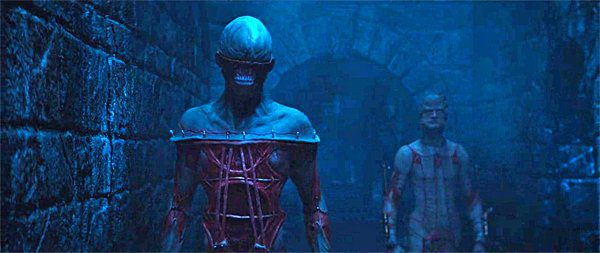“We have such sights to show you.”
I figured I owed Clive Barker a fairer shake than I initially gave him when I shat all over Hellraiser a few years ago. Sure, his brand of baroque Gothic sexual deviance isn’t quite up my alley in terms of horror, but so many writers and filmmakers – Stephen King, Grady Hendrix, Paul Trembly, Nadia Bulkin – whom I admire seem to hold Barker in high esteem. Imajica, for instance, is often cited as one of the twentieth century’s defining works of fantasy. So did David Bruckner’s 2022 re-imagining of Hellraiser turn me around on this franchise, or on Barker himself? Honestly, not really, but make no mistake: this movie is pretty good.
Bruckner’s Hellraiser isn’t a direct adaptation of the original source material, Barker’s story “The Hellbound Heart.” The funny thing about this franchise is that it’s not “about” the Cenobites (even though, let’s be real, it’s pretty much about the Cenobites) so when adapting it, you can make the framework as loose or slavish as you want, as long as you touch on the same central themes. So rather than watch the world’s worst woman, married to the world’s most boring man, murder people to resurrect the world’s least charming sex pest, we can watch a recovering addict try to accept her world for what it is. That sounds like a drag, but this is a demonstrably better movie than the original.

We open at a Saltburn meets Eyes Wide Shut-style orgy – to really hammer home the analogy, the first character we meet, Joey, looks like a dollar-store Jacob Elordi. He’s dispatched quickly and gruesomely by the franchise’s famous puzzle box, which here is nearly sentient in a way that brings to mind the creepy morphing dagger from The Phantom (remember The Phantom? No? Just me?). This scene – in which we also meet our main antagonist, Jeffrey Epstein stand-in Roland Voight, played with terrific, charming sleaze by Goran Visnjic – is illustrative of Bruckner’s approach to the material, and it comes down to one word that I don’t think Clive Barker knows: restraint (ironic, given the BDSM trappings of Barker’s work). We only see the hooks and chains of the Cenobites in the background; the foreground is dominated by Voight’s devotion to the ritual.
Six years later, the box winds up in the possession of Riley, a recovering addict crashing at her brother’s house. Riley is an interesting character, because Hellraiser is absolutely uninterested in making her perfect, or, at times, even likable. To be fair, her brother (Matt) and his boyfriend (Colin) are also judgmental and nosy. There’s also her inexplicably British roommate, Nora, who doesn’t really factor into the story much at all; and Riley’s boyfriend, Trevor, a fellow addict who seems very cavalier about offering Riley beer. Overall, maybe not the most pleasant group of people to be around (including and especially our lead) but at least there’s something there. And the acting is worlds better than in Barker’s version. Odessa A’Zion, as Riley, is genuinely fearless, and delivers a performance of admirable emotional nuance that does nothing to belie her age at the time of filming.
After Matt kicks Riley out of his house due to a relapse, he gets worried and goes looking for her, finding her unconscious in a park, the puzzle box in her hand. It stabs him, just like it did Joey, and as Matt washes his wound the movie seems to begin in earnest. The bathroom wall gives way, revealing ancient stone corridors (which look like they might be reused assets from the first film, which if true is very cool). One thing you can’t deny about Hellraiser is that it looks incredible. Bruckner’s strength, shown here as in his excellent film The Ritual, is in showing us these brief glimpses of a hell beyond our imagination. Once again, imagination and insinuation trumps blood and guts.

But what of the Cenobites? Realistically, no matter how good the other components of the film are, Hellraiser lives or dies on the strength of its inter-dimensional sadistic demons. I’m happy to report that the Cenobites look terrific. There are fabulous little touches that set them apart from each other; some seem completely flayed open, while others still have swatches of skin, as if they haven’t yet ascended in the ranks. There’s a kind of gruesome hierarchy at play here. The names, never spoken aloud, are suitably chilling, and a far cry from the original’s lackluster sobriquets such as Butterball and Female Cenobite. There’s the Masque, the Rasp, the Asphyx, the Chatterer, and the Priest, this Hellraiser’s name for Pinhead (a nickname that Barker hates). As played by Sense8’s Jamie Clayton, this Pinhead is leagues more interesting than the only played by Douglas Bradley in Barker’s original, because Clayton is a good actor and Bradley isn’t. She’s fantastic at micro-expressions, easily conveying curiosity and annoyance when it’s called for. Her voice is pitched to an almost neutral frequency, making Pinhead truly androgynous (casting a trans actress for this role was a stroke of genius, honestly).
Barker’s film excelled when it embraced its Gothic trappings, which worked so nicely with Christopher Young’s eerie, bombastic score. Bruckner’s Hellraiser is no different. The climax of the film is gory and operatic, and it comes closest (to me, at least) in visualizing the appeal of Barker’s Grand Guignol theatrics. I won’t get too much into details – because, again, I’m actually recommending this one – but there is some truly striking, audacious imagery on display. I didn’t come into this Hellraiser expecting to love it, but I also wasn’t expecting a surprisingly artful dramatization of the Serenity Prayer. I haven’t come around on this franchise, or Barker as an artist, but it’s nice to know that after almost a decade of doing this column I can still be pleasantly surprised.

